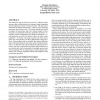Free Online Productivity Tools
i2Speak
i2Symbol
i2OCR
iTex2Img
iWeb2Print
iWeb2Shot
i2Type
iPdf2Split
iPdf2Merge
i2Bopomofo
i2Arabic
i2Style
i2Image
i2PDF
iLatex2Rtf
Sci2ools
108
Voted
IMC
2007
ACM
2007
ACM
Interference map for 802.11 networks
The interference map of an 802.11 network is a collection of data structures that can help heuristics for routing, channel assignment and call admission in dense wireless networks. The map can be obtained from detailed measurements, which are time consuming and require network down time. We explore methods and models to produce the interference map with a reduced number of measurements, by identifying interference properties that help to extrapolate complex measurements from simple measurements. Actual interference in an 802.11a testbed is shown to follow certain regularities – it is linear with respect to packet rate of the source, packet rate of the interferer, and shows independence among interferers. When multiple cards are available, they behave differently, and even different channels of the same card have different performance. We find that while current methods of gathering the interference map may be appropriate for characterizing interference in one card networks, they ar...
Related Content
| Added | 26 Oct 2010 |
| Updated | 26 Oct 2010 |
| Type | Conference |
| Year | 2007 |
| Where | IMC |
| Authors | Dragos Niculescu |
Comments (0)

